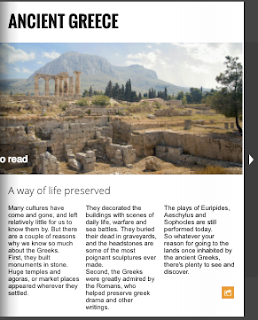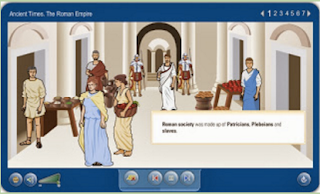Sunday 4 December 2016
ROMAN DOMUS
Romans had a wide range of housing. The wealthy could own
a house (domus) in the city as well as a country farmhouse
(villa), while the less fortunate lived in multi-story
apartment buildings called insular.
Wealthy and influential Romans owned larger
and more opulent housing complexes in the
cities called ‘Domus’.
A typical domus had a door towards the street
the opened into an entrance hall that lead to a
courtyard called ‘Atrium’. Atrium was a central hall
with rooms all around it. The master of the house
known as Dominus had his and his family’s rooms
all around the atrium.
a house (domus) in the city as well as a country farmhouse
(villa), while the less fortunate lived in multi-story
apartment buildings called insular.
Wealthy and influential Romans owned larger
and more opulent housing complexes in the
cities called ‘Domus’.
A typical domus had a door towards the street
the opened into an entrance hall that lead to a
courtyard called ‘Atrium’. Atrium was a central hall
with rooms all around it. The master of the house
known as Dominus had his and his family’s rooms
all around the atrium.
Atrium either had no roof or a hole in the roof to serve as
a sky light and an opening to allow rain water
to fall through it and get collected in a reservoir
in the center of the atrium floor.
There were multiple rooms in a domus which were used
for different purposes.
Beyond an atrium centered complex was the rear portion
of the house which was centered on
a garden or backyard called’Peristyle’. The rooms around
peristyle were toilets, kitchens, stores and slave quarters.
Romans decorated their rooms with colored
plaster walls and mosaics. Mosaics were expensive
and only the very rich could afford them.
a sky light and an opening to allow rain water
to fall through it and get collected in a reservoir
in the center of the atrium floor.
There were multiple rooms in a domus which were used
for different purposes.
Beyond an atrium centered complex was the rear portion
of the house which was centered on
a garden or backyard called’Peristyle’. The rooms around
peristyle were toilets, kitchens, stores and slave quarters.
Romans decorated their rooms with colored
plaster walls and mosaics. Mosaics were expensive
and only the very rich could afford them.
The furniture used was rather basic in nature.
Most of the Romans used stools for sitting
and beds for sleeping. Unlike insular,
domus were supplied with water through lead pipes.
The owners of the houses were taxed for it however.
The tax depended on the size of pipes
provided. Many Romans installed hypocaust
for under floor heating of their rooms.
This provided them with a comfortable environment
inside their houses.
IF YOU WANT TO KNOW MORE ABOUT
ROMAN DOMUS,
YOU CAN VISIT THE FOLLOWING WEBSITE:
Most of the Romans used stools for sitting
and beds for sleeping. Unlike insular,
domus were supplied with water through lead pipes.
The owners of the houses were taxed for it however.
The tax depended on the size of pipes
provided. Many Romans installed hypocaust
for under floor heating of their rooms.
This provided them with a comfortable environment
inside their houses.
IF YOU WANT TO KNOW MORE ABOUT
ROMAN DOMUS,
YOU CAN VISIT THE FOLLOWING WEBSITE:
ANCIENT GREECE
IF YOU WANT TO KNOW MORE ABOUT ANCIENT GREECE, YOU CAN VISIT THE FOLLOWING WEBSITE:
https://www.flipsnack.com/socialestrinidad/new-flip-1.html
Can you really visit ancient Greece?
Yes, there are still some magnificent remains of this ancient way of life to be seen during a visit to Greece.
If you travel to Greece it would be a shame to stay in such a wonderful country and not appreciate its history and culture.
Whether you already have an interest in ancient Greece or a visit to an ancient site is something you might 'do' while you're there, a fascinating world awaits you.
A lasting legacy
There are not many civilizations going back over 3000 years which have left so much of their workmanship for us to admire today.
"Mighty indeed are the marks and monuments of our empire which we have left.
Future ages will wonder at us, as the present age wonders at us now."
Pericles, 5th century BC
Future ages will wonder at us, as the present age wonders at us now."
Pericles, 5th century BC
https://www.flipsnack.com/socialestrinidad/new-flip-1.html
UNIT 6. ANCIENT HISTORY
In this unit we are going to learn about
PHOENICIANS, ANCIENT GREEKS, CARTHAGINIANS AND ROMANS.
VIDEO WITH THE TERRITORIAL EVOLUTION OF THE ROMAN EMPIRE
CLICK ON THE PHOTOS TO LEARN MORE
IF YOU WANT TO KNOW MORE ABOUT PRIMITIVE PEOPLE, YOU CAN VISIT THE FOLLOWING WEBSITES OR VISIT THE FOLLOWING MUSEUMS:
It was a very big Empire....!!! But it was not always like this.... In the following video you can see the territorial evolution of the Roman Empire, how the Roman Empired started, how it grew bigger and bigger... and how finally it became smaller and smaller until it disappeared.
YOU CAN VISIT A ROMAN HOUSE:
ROMAN EMPIRE
Rome is the capital city of Italy, but in the past it was even more important... It was the capital of the Roman Empire... And the Roman Empire was huge. It was settled in a very large part of Europe, in some parts of Asia, and the North of Africa.
The Romans Empire was so big, that even all countries or land around the Mediterranean Sea was part of the Romans Empire.... This is why they called the Mediterranean Sea "Mare Nostrum", which means "Our Sea", (in Spanish "Mar Nuestro").
LOOK AT this map of the Roman Empire. All coloured countries or provinces were part of the Roman Empire. As you can see the Roman Empire was placed along what nowadays is Spain, France, England, Switzerland, Italy, Austria, Romania, Bulgaria, Greece, Malta, Chipre,Turkey, Israel, part of Morocco, Argelia, Libia, Tunez, Egipt.
Subscribe to:
Posts (Atom)








